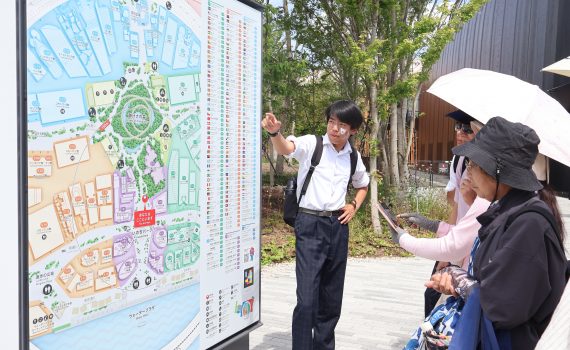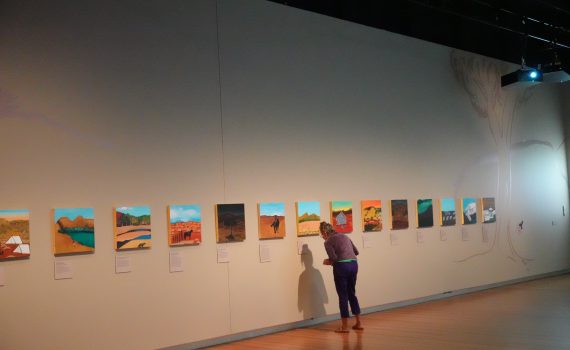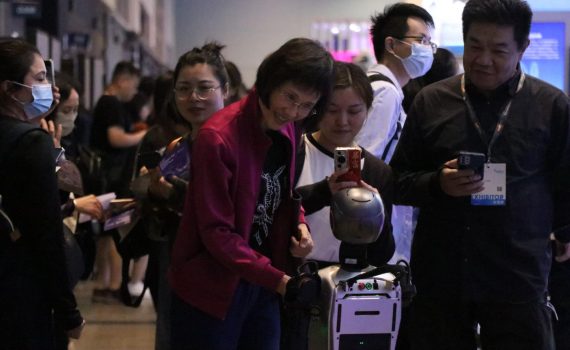Society
LGBT-friendly gyms provide safe environment for non-binary bodybuilders
- 2025-06-23
- Society
- The Young Reporter
- By: SIU Tsz Hang、CHEN XiyunEdited by: Lok Tung LAU
- 2025-06-23
There are more than 10 LGBT-friendly gyms in Hong Kong, targeting the LGBT+ community in Hong Kong. It is to provide a comfortable place for the LGBT and to ensure they feel safe and secure. Reported by Henry Siu Tsz-hang, Richard Chen Xiyun Edited by Canny Lau Lok-tung
Confusion over navigation app at Osaka Expo 2025
- 2025-06-09
- Society
- The Young Reporter
- By: ZHANG Yiping、CAO JiawenEdited by: CAO Jiawen、ZHANG Yiping
- 2025-06-09
Osaka Expo 2025 is supposed to showcase futuristic technologies, but some visitors experience were confused by the official app which was meant to offer with navigation and language support. The app, called “EXPO 2025 Visitors”, has a 2.3/5 rating on Google Play with over 500k downloads, with many users complaining about the slow function, clunky interface, and glitchy performance. “It would be nice if they had a map with the pavilion names on the app, because we have to click on every button to see what it is,” said Frank Johnson, 37, a tourist from the United States. “First we used the maps on the website and then the maps on the app, but we kept getting lost,” said Helen Okoro from the United States. “It’s because there aren’t really any signs with pavilion names in general.” Tourists can buy a paper map for 200 yen at the venue, but the line is usually very long. According to the official website, the map is not distributed free of charge due to sustainability concerns. Across the venue, groups of volunteers are placed to help visitors find their way. “Lots of tourists need help with directions in the venue,” said a Japanese volunteer who chose not to reveal her name for fear of getting into trouble. “It is generally circular, so it’s hard to tell the direction,” she added. Angela Zhou, a Chinese visitor aged 28, said the paths inside the venue are confusing. “Google Maps is much more useful compared to their official app,” she said. “It allows you to directly search for each pavilion and head straight to it, while the official app is slow.” “Many of the app’s functions require you to visit the website on a browser. For example, clicking on the booking button on the app just …
Photo Gallery: South Koreans choose their new president after six months of political chaos
- 2025-06-05
- Society
- The Young Reporter
- By: Wang Yunqi、BO ChuxuanEdited by: BO Chuxuan
- 2025-06-05
The South Korean presidential election wrapped up with liberal party leader Lee Jae-myung winning the presidency and being sworn in on June 4, bringing an end to six months of political chaos since martial law. Lee Jae-myung won with 49.42% share of votes, amounting to 17,287,500 ballots, the largest number of votes in South Korean presidential election history, according to Yonhap News Agency, while voter turnout reached 79.38%, the highest since 1997, reflecting a high level of public mobilisation. Besides Lee’s victory, Kim Moon-soo, leader of the conservative People Power Party, received 41.15% of the vote, as the previous party leader’s martial law declaration received wide criticism, with Lee Jun-seok of the Reform New Party securing 8.34% of the votes, who emphasised on political reform and youth empowerment. The remaining two candidates, Kwon Young-guk and Song Jin-ho, received 0.98% and 0.1% of the votes, respectively. According to a May poll conducted by Gallup, there were notable differences in support rates across age groups. Lee Jae-myung enjoyed higher support among people in their 40s and 50s, while Kim Moon-soo was more favoured by those in their 60s and 70s. And Lee Jun-seok received relatively greater support among younger voters. South Korea faced significant disruptions in high-level diplomatic activity following ex-president Yoon declaring martial law on Dec. 3, 2024, with domestic investors suffering “roller coaster” fluctuation of both the stock market and currency, also driven by the tariff policy initiated by US President Donald Trump. With concerns for the country’s social and security landscape raised, Lee outlined five key missions for his administration during his victory speech, including ending internal conflict, achieving national unity, revitalising the national economy, ensuring national security, and maintaining stability on the Korean Peninsula. “This is a world where things like martial law shouldn’t exist”, said Lee Eungyeong, …
Number of visitors at the Osaka Expo hits record high
- 2025-05-29
- Society
- The Young Reporter
- By: ZHANG Yiping、CAO JiawenEdited by: CAO Jiawen、ZHANG Yiping
- 2025-05-29
The Osaka Expo drew approximately 139,000 visitors on May 23rd, breaking the record for the highest number of visitors on a single day, despite ongoing complaints over confusing booking systems and long waiting times. The total number of visitors exceeded 5 million on May 26th, 44 days into the six-month event, according to the Japan Association for the 2025 World Exposition. But that still falls short of expectations, as the Expo is projected by the association to have a total of 28.2 million visitors (150,000 daily). “The waiting time for each pavilion is very long,” said a Japanese couple, Kayo Aoshima and Yoshiaki Aoshima, aged 82 and 78. “We went to the Arab Pavilion, where we had to wait for more than 30 minutes.” Kayo added. Pavilions at the Expo have different admission strategies. While a few only allow for those who have booked in advance to enter, others allow on-site queuing. With each ticket, visitors can make one reservation for one pavilion or event through a lottery system seven days before their visit. They can also reserve or adjust bookings during the three days leading up to their visit, which operates on a first-come, first-served basis. “We have visited many pavilions, such as the USA, Colombia, and the Netherlands, ” said David Aragon, 40, a Mexican tourist.“We had to wait for around one hour at each one of them.” “Maybe more info outside the pavilions to know what is inside and exactly where we can enter something,” added Aragon. Nishijima Ryo, chief of Japan Association for the 2025 World Exposition, who was overseeing work at the Future of Life Pavilion, explained why only visitors with reservations could be admitted. “In this pavilion, you can wear an earphone device and experience the exhibition,” he said. “The number of machines is limited, so we limit …
Piu Sik parade returns to Cheung Chau on Buddha’s birthday
- 2025-05-09
- Society
- The Young Reporter
- By: AO Wei Ying VinciEdited by: AU YEUNG Jim
- 2025-05-09
Some 20 floats paraded down the streets of Cheung Chau along with children dressed up as celebrities on the annual Jiao Festival on May 5, the Buddha’s birthday. The parade kicked off at Pak She Street at 1:30pm, passing through New Hing Street, Tai Hing Tai Road, Secondary School Road, Chung Hing Street, Tai Choi Yuen Road, Tai Sun Back Street, Hing Lung Main Street, New Hing Back Street, and concluded at Pak She Street again at around 4:30pm. Cheung Chau Jiao Festival, also known as the Bun Festival, is a Hong Kong folk festival that’s supposed to give thanks to the deities. This year, characters from mainland Chinese animation Ne Zha 2 were a hit. Children also dressed up as National Games athletes, members of the “KK Park” scam group in Myanmar that detained Hong Kong residents, and the Hong Kong police’s anti-scam mascot “Little Grape.” The children in costumes, known as Piu Sik, sat on stilts carried by adults during the parade. One of the performers included a girl wearing a sun hat and an orange shirt holding up a sign, to warn the public against scam farm jobs. Spectators lined the streets under the scorching sun and in the humidity. “This is my first time at the parade. My favourite “Piu Sik” is Ne Zha because I liked the movie a lot,” said Xuan, 10, a Beijing tourist in Hong Kong with his parents during the “Golden Week” holiday in the mainland. “I think this year’s Piu Sik parade is not exceptional since I have attended this event for 20 years already,” said Poon Lai-yin, 50, a Tin Shui Wai resident. “I hope I don't have to wait too long for the ferries when I leave. The arrangement last year was really messy.” On-site police announced crowd …
Navigating Hong Kong malls with sight impairment
- 2025-05-07
- Society
- The Young Reporter
- By: CHEN Yik Nam、LI Sin Tung、CHAN Wing Yiu、Cheuk Chi Maggie YEUNGEdited by: Jenny Lam
- 2025-05-07
Accessible facilities, especially tactile paths for the blind are either inadequate or improper in most of the malls, no matter in Hong Kong or Shenzhen. Despite the government regulations on accessibility for people with sight impairment, related malls’ respondents and government departments avoid replying directly.
Closure of Deliveroo Reveals Unfair Work Conditions, Users Concerned about Delivery Fee
- 2025-05-04
- Society
- The Young Reporter
- By: ALISHIBA MATLOOB、Wing Chi HOEdited by: Chun Lim LEUNG
- 2025-05-04
After nine years, British food delivery giant, Deliveroo, officially ceases operations in Hong Kong. As the platform shuts down, riders and users are left with the impacts of shrinking wages and legal gaps, rising delivery fees, and fewer choices. Our reporter Gigi Ho reveals how the remaining platforms may be driving a deeper crisis in worker protections, given in example in Keeta’s "K-GO", a system that promises more orders in exchange for lower pay. (April 7, 2025) Reporter: Ho Wing-chi, Alishiba-Matloob Editor: Chun Lim LEUNG
As Australia’s Indigenous Languages Disappear, Experts are Working to Save Them
- 2025-04-30
- Society
- The Young Reporter
- By: CHAU Wing YauEdited by: KURNIAWAN Trista Vania
- 2025-04-30
Indigenous languages in Australia are endangered. Australia has more than 250 Indigenous languages and around 800 dialects, but only 150 are still spoken today, according to the Australian Insitute of Aboriginal and Torres Strait Islander Studies, From European colonisation in the 18th century until the mid-20th century, Aboriginal communities were forbidden to speak their Indigenous languages. Now, most fluent speakers are elders and younger generations often don’t speak them at all. Last month, the Australian government unveiled its 2025 budget which included AU$ 3.6 million to continue digitising at-risk audio and video collections of Indigenous languages. We spoke to experts working on preserving and revitalising these languages for the next generation.
Kowloon City celebrates Songkran Festival
- 2025-04-24
- Society
- The Young Reporter
- By: SIU Tsz Hang、CHENG Tsz Sen SeanEdited by: AO Wei Ying Vinci
- 2025-04-24
Songkran Festival, a Thai New Year celebration, made its comeback in Kowloon City April 11 to 13. "Day X Night Vibes @ 18 Districts – Thai Festival: Songkran 2025", featured a water splashing, a pop up food market, Thai dance performances, Thai costume experiences, Muay Thai demonstration and boxing match. The highlight was a parade heading toward Tak Ku Ling Road. Reported by Henry Siu Tsz-hang, Sean Cheng Tsz-sen Edited by Vinci Ao Wei-ying
Humanoid robots shines at InnoEX
- 2025-04-19
- Society
- The Young Reporter
- By: CHEN Xiyun、CHEN ZiyuEdited by: WANG Jing
- 2025-04-19
A humanoid robot dances to music. Others clap to the beat, or make eye contact through vision sensors with the audience. These bots are all the rage at the third sci-tech exhibition InnoEX at the Hong Kong Convention and Exhibition Centre from Apr.13 to 16 this year. Co-organized by the Technology and Industry Bureau and Hong Kong Trade Development Council and themed with “Innovate, Automate and Elevate”, this exhibition spotlights robotics, low-attitude economy, AI, smart mobility, and cybersecurity, according to the official news release. “These robots can already be applied in certain scenarios like playing football games. They can identify objects and take actions like shots and dribbling.” said Liu Weitong, 32, head of commercialization at Booster Robotics. “Humanoid robots can provide basic services like guidance and performance, but it will take at least two to three years for the industry to provide mature products for factories or families,” she added. She explained the limited load-bearing weight of the robot's arm is such that they cannot be used in large-scale industrial production. The algorithms at the current level also cannot fully guarantee the safe use of robots in the home. “Similar to human beings, robots set their goals based on basic logic, such as ‘who am I, where am I right now, and where I should go,” said Calvin Chiu, the COO of Novautek Autonomous Driving Limited, an exhibitor at InnoEX. “The AI algorithm helps humanoid robots understand the surroundings and connect the decoded information with their goal to guide their action,” Chiu said. Existing algorithms, he explained, can only let humanoid robots accomplish the goal based on training data. “We still need time to make humanoid robots more widely available to the public,” he said. Over 500 exhibitors from 17 countries and regions joined the exhibition this year. New …










